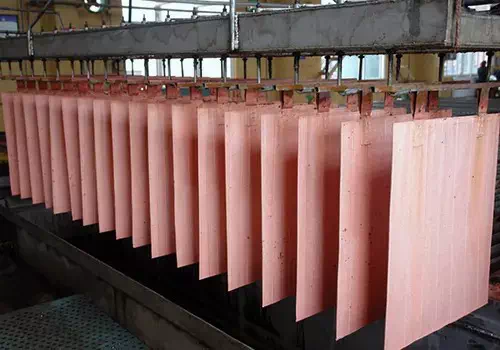Manufacture of anode plates in metal (e.g. copper) refining processes carried out after conversion processes. The product obtained from the flash smelting furnace contains iron, sulfur and precious metals other than copper, and the iron and sulfur are removed by means of oxygen-enriched air during the conversion process. The converted copper thus obtained is conveyed to the anode furnace where it is further purified to remove sulfur. Sulfur that may remain in the anode furnace during the conversion process is oxidized to sulfur dioxide by blowing air into the liquid metal. Then, oxygen is removed from the melt.

Molten copper from the anode furnace is cast by an anode casting facility into anode plates, which contain approximately 99.5% copper. Typically, the anode plate measures about 1 meter by 1 meter and has a thickness of about 5 centimeters. Anodes typically include lifting lugs by which the anode can be lifted and suspended in a vertical position for electrolysis. Typically, the anode weighs about 300-400 kg. Then, the processed anode plate is purified into a copper cathode by electrolysis, and its copper content is 99.99%.
The most widely used currently known anode casting apparatus consists of a casting table rotating about a vertical axis and comprising a plurality of open molds arranged in a circle. The casting table rotates periodically such that each rotation is followed by a stop of a specified duration.
In this anode casting plant, copper is conveyed from an anode furnace along a launder to a casting machine and further conveyed to an open mold made of copper. The molten copper is prevented from sticking to the mold by coating the mold with a mold coating or release agent which may include, for example, barium sulfate mixed with water during each cycle. Casting consists of the following stages casting, cooling, demolding, lifting into cooling baths and coating the mould.
An anode cast in a mold cannot cool down before its surface is sufficiently solidified. Immediately after casting, the temperature of the molten anode in the mold is about 1150°C (its melting point is 1084°C), and the molten anode should usually be cooled in the mold to a temperature of 700-950°C where it has been Allow to cure sufficiently for release.
When starting casting, the temperature of the copper mold of the casting anode is not lower than about 60°C at the beginning of casting, and usually reaches equilibrium during three cycles of the casting table, whose internal temperature is about 200°C and outside the casting table The end face surface temperature measured in the middle was about 150°C. Now, in order for the life of the mold to not be too short, the mold must not be too hot. In this case, the water-dilutable mold release agent sprayed on the mold surface after removal of the anode also dries sufficiently so that no splinters form on the edges of the anode cast in the mould. If the release agent is sprayed on the surface of a subcooled mold, the release agent does not have time to dry before casting begins in that mold. Keeping the mold at an optimum temperature is essential for the overall cooling of the mold and anode, and thus makes it possible to cast an anode of sufficient quality for electrolysis.
Thank you for your interest in suny group. If you want to learn more about our E-waste recycling plant, copper wire recycling machine and other machines, Contact us now to find out what we can do for you next project!E-mail:sunymachine@gmail.com | Whatsapp:+8613674945231